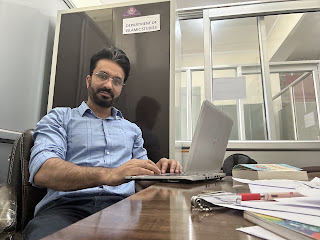ON THANNAMANDI
|
T |
hanamandi, in district Rajouri, is more than just a place—it’s where I’ve permeated a few more curtains of life, where hardship meets hope, and where growth and challenges coexist in the most unexpected ways. Located in the Rajouri district of Jammu and Kashmir, Thannamandi is a vibrant, close-knit community deeply ingrained in the region's cultural and spiritual fabric. Here, every house, every individual’s story, and every struggle are known to all, creating a unique sense of belonging amid challenges. It is a place that may seem abundant at first glance but is deeply woven into the cultural Muslim fabric.
I
have made friends all along the Pir Panjal range across all cultures and
religions, in colleges, with shopkeepers, and with gym-goers. I discovered my
own self with these people and associated myself with their culture and eating
habits. I travelled with them, laughed at their humour, entertained them with
gossip, and had late-night chats and dinners. Their warmth is truly remarkable, welcoming guests
with open hearts. Even shopkeepers in Thannamandi embody a rare humility, often
urging buyers to keep their money—a gesture unique to this land. They will
never give up inviting you to their home, a feature shared with Kashmiri
hospitality. I acknowledge their presence in my life and record my gratitude
for these wonderful souls. I would love to preserve their vigorous vibes in my
life.
To the unknowing eye, it might seem like life here hasn’t been easy, especially before the construction of roads and the arrival of engines. It must have been difficult to connect with the outside world. Such isolation could be one of the reasons that the people of Thanamandi live within their self-contained bubbles, each facing their own oppressive identities and economic hardships.
From an aerial perspective, the place radiates an incredible ambiance. It’s mountain after mountain with no plains, and houses are constructed on the balconies of these mountains. The view from the house balconies offers a view of the Thannamandi area. The open rooftops and viewshed topography allow residents to observe each other's morning walks, parked vehicles, distant cricket matches, migrating sheep, swiftly flowing murky canal waters, small meadows, some pine trees, mosques with Persian art decorations, schools, and clothes drying on verandas. The Panjal range, covered with snow, looms alongside army camps and police stations. Everything is visible. This visibility permeates privacy, which is minimal due to the open and accessible nature of the area. The view from my friend’s home on Thannamandi Road, which leads to Bhangai Valley, provides a clear line of sight to almost everything around—from houses to institutions like hospitals and police camps—creating a sense of transparency but also of overexposure. People in such areas might feel like they’re constantly being watched or observed, even in private moments. The concept of gossip in this setting is quite natural, as people are aware of each other’s activities, and with fewer physical barriers, curiosity or even social interaction might lead to a lot of talk. It's fascinating how the environment itself can influence the way people interact with each other.
Living
here also gave me a few chances to travel to the Pir-Punjab
mountains—a destination I had always dreamed of visiting. Time and again, I
planned to venture there, but the persistent fear of military presence in the
area kept me from making the trip. The presence of military installations
narrates the story of the conflict this region has witnessed, especially in the
1990s. Army camps, one after another and spaced just a few kilometres apart, so that life here is like watching every movement.
Education to Thanamandi Rajouri came very late, yet despite this, generations here, at
least three, have shown academic resilience and success. Educational institutions like MET, Kerala, and Yaseen International, followed by other government schools, have played a crucial role in this transformation, imparting quality education and equipping students for future endeavours. The progress is
good, if not the best. Students here excel at getting lucrative jobs; many achieve significant success in competitive fields.
But the story isn’t all rosy. Upon examining the broader picture, we notice visible fractures in the foundation. Despite the academic achievements, Thannamandi’s society reflects a troubling lack of leadership and infrastructural development. The educational institutions, while successful in producing graduates, haven’t fully sparked the societal transformation one might hope for.
The
resilience that students show in the classroom doesn’t seem to translate into
challenging bad governance or demanding better infrastructure. There’s a sense
of complacency, as if people have grown accustomed to settling for less. Students' unheard voices and lack of freedom of expression raise questions
about the educational system itself. Even with a significant number of locals
recruited into the administrative system, the concerns of ordinary people
remain ignored, muffled by a culture that stifles open dialogue.
This issue isn’t just about schools failing to produce leaders; it’s about a deeper
disconnection. Education should empower students to question, to advocate, and
to drive change. Yet, in Thannamandi, the system seems to fall short of
fostering that spark. The mountains may offer breathtaking views, but they also
seem to echo a silence where bold voices should resonate.
Thannamandi’s
journey with education is a testament to human resilience, but it’s also a
reminder that academic success alone isn’t enough. For true progress, the town
needs leaders who can harness this resilience to address governance issues,
improve infrastructure, and amplify unheard voices. The schools have laid a
foundation; now, it’s time for the community to build on it, promoting an
environment where students feel free to speak, question, and lead.
The
story of Thannamandi is still being written. With its vibrant youth and growing
educational legacy, there’s hope that the next chapter will see not just
academic triumphs but a society that thrives in every sense—visible, vocal, and
victorious.



Though I have never been to there but I expect to traverse such unknown paths sometime in the future...
ReplyDelete